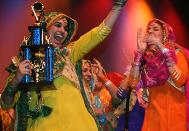| Connecting
over 25 millions NRIs worldwide |
|
|||||||||||||||||||||||
|
||
| Bhangra is a traditional form of dance and music which originates from the Punjab region of India and Pakistan. It was initially used as a celebratory folk dance which heralded the coming of spring, or Vaisakhi, as it is known. Bhangra is a mix of a singing accompanied by music and the beat of a single drum known as a dhol. The dhol is a large, high-bass drum, played by beating it with two sticks - known as daggah (bass end) and tilli (treble end). .......Read The term Bhangra has come to incorporate a whole host of these dance forms including Jhumar, Luddi, Giddha, Julli, Daankara, Dhamal, Saami, Kikli, and Gatka. Major migrations of the Sikh Punjabis to the UK brought with them the Bhangra music, which became popular in Britain during the 1980-1990. Originally, Bhangra dancing was perceived as a male dance, a "man's song", with strong, intense movements. However, "Second-generation South Asian American women are increasingly turning to bhangra as a way of defining cultural identity. Women wear a traditional Punjabi dress known as a ghagra. Malkit Singh- one of the biggest Bhangra stars of the last several decades. In 1983 he won a gold medal at the Guru Nanak Dev University, in Amritsar, Punjab, for performing his hit song Gurh Naloo Ishq Mitha, which later featured on his first album, Nach Gidhe Wich, released in 1984. It was a strong hit among South Asians worldwide, and after its release Malkit and his band moved to the United Kingdom. He produced 16 albums and has toured 27 countries in his Bhangra career. He has been awarded the prestigious MBE by the British Queen for his services to Bhangra music. Gurdas Mann, a multi-talented Punjabi folk singer from the Punjab and took Punjabi folk music (not bhangra music) world by storm. He started his career in 1980 with his first album, Dil Da Mamla, followed by his huge hit Masti. He appeared in the Punjabi film Long Da Lishkara with mega hit Challa. He has released a number of hit albums, sold-out concerts around the world, and has released many popular singles, including "Apna Punjab". Channi Singh, Southall, UK (group Alaap), famous by his white scarf, album "Teri Chunni De Sitaray", released in 1982 by Multitone. Alaap (music oozed perfection) were unique with a live-set that was the best ever to play on the Bhangra stage. Several other influential groups and artists are :
British, NRI artists, such as Bally Sagoo, Talvin Singh, Badmarsh, Black Star Liner, and State of Bengal began incorporate bhangra, Indian sounds and lyrics to creat their own form of British hip-hop In 1990, the rise of several young Punjabi singers and many other artists returned to the original, folk beats of Bhangra, often incorporating more dhol drum beats and tumbi. The very first boy band called the Dosanjh's, a band made up of five brothers from Talwan, India. Their music is a fusion; Bhangra, Rock and Dance fused with their very own distinctive sound. In 1992, Jazzy Bains ( Jaswinder Singh Bains), Canadian folkster, has become one of the best-selling Bhangra artists in the world and sold over 55,000 copies of his second album, "Folk and Funky". He has taken up a particularly modern, hip-hop. In 1995, a trend towards the use of hip-hop mixed with traditional rhythm instruments such as tumbi and dhol, started. Daler Mehndi's tracks such as "Bolo Ta Ra Ra" and "Ho Jayegee Balle Balle" has made the sound of Bhangra-pop a craze amongst many non-Punjabis in India, selling many millions of albums and even sold 250,000 albums in Kerala, where no Punjabi is t spoken. Bally Sagoo, Remix artist, raised in Birmingham, UK, bring on the funky-drummer beat, bring on the James Brown samples", to Time magazine in 1997, inspite of Indian sound tablas. He also signed by Sony as the flagship artist for a new sound. Bhangra include combination of dances such as Jhumar, Luddi, Giddha, Julli, Daankara, Dhamal, Saami, Kikli, and Gatka. Pepsi commercial launched in Britain featured South Asian actors and Bhangra music. This is a true sign of Bhangra popularity. Bhangra continues to gain popularity in both the UK and US. In 1980-1990, BMG bought one of the major recording labels associated with Bhangra in Britain. Remixes was growing popularity in 1990s but cane to an end. NRI, DJs, especially in USA have mixed Bhangra music with house, reggae, and hip-hop to add a different flavor to Bhangra. Fitness: Sarina Jain, television host as fitness instructors, have developed fitness routines based on bhangra dance moves for their workout programs.
The bhangra industry has not grown in North America nearly as much as it has grown in the United Kingdom.
|
||
| |
|
|

